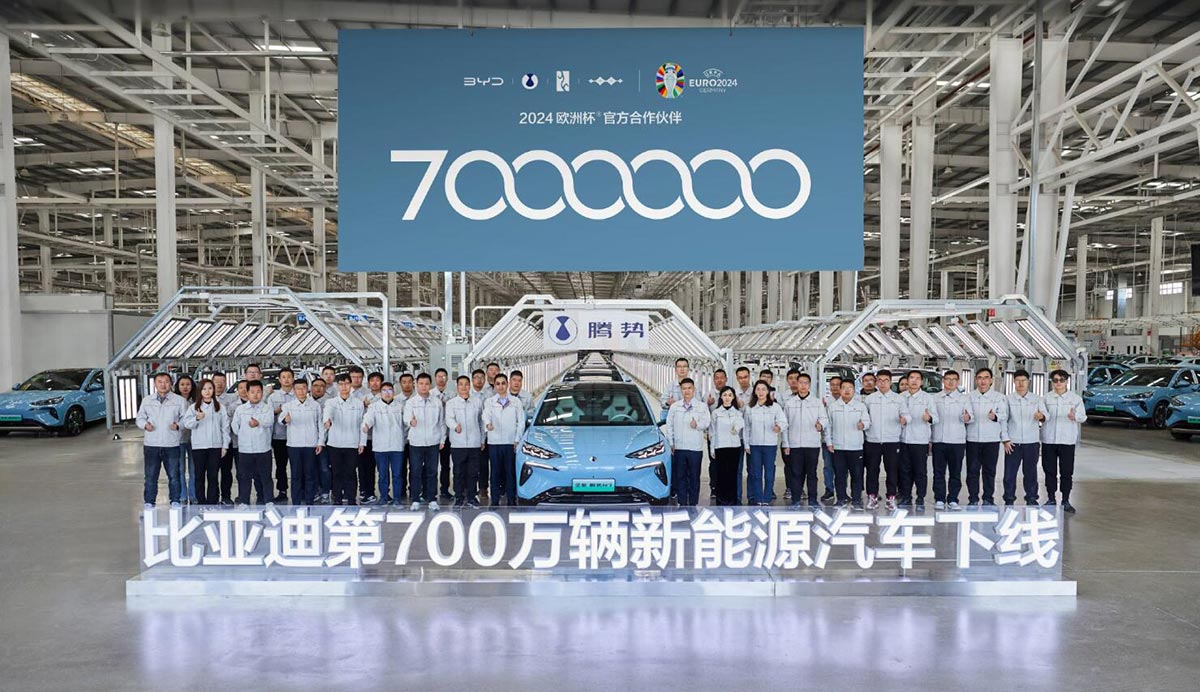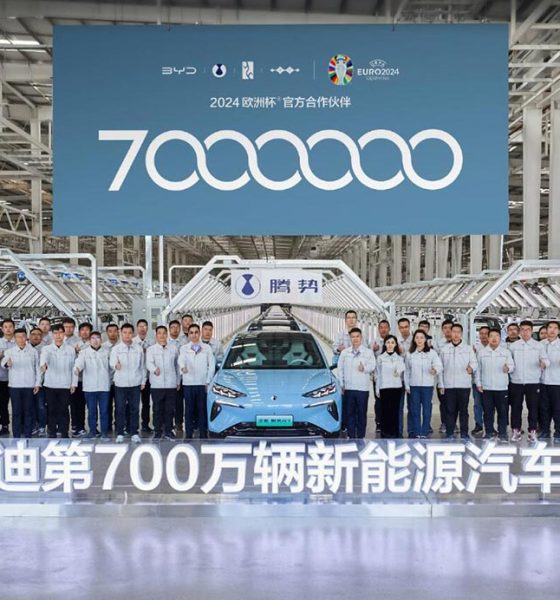BYD and other Chinese automakers have studied the European auto market for years. Now, it’s time to put their knowledge to the test and go all-in on the European auto market.
BYD’s strategy to take over Europe was recently revealed in a report by Reuters. The publication also shared details about how other Chinese automakers are entering the European market and their plans to beat top-selling brands like Tesla and Volkswagen in the EU’s local electric vehicle (EVs) market.
Below are the strategies BYD and Chinese automakers are implementing to deploy their vehicles in Europe.
- Understand European car consumers and their needs
- Improved marketing to increase brand awareness
- Expand dealership networks
- Build an extensive after-sales care service network, including improved service-and-repair operations.
- Protect resale values
The roads are buzzing with SUPER DM technology. The BYD SEAL U DM-i combines a range of more than 1000km with an attention to detail in every inch of its interior. It's the perfect synthesis of comfort and adventure.#BYD #BuildYourDreams #BYDSEALUDMi pic.twitter.com/gSNGtLzQV4— BYD Europe (@BYD_Europe) May 22, 2024
China Cars with Europeans in Mind
BYD and Chinese automakers have learned that adapting and importing cars from China to Europe is not enough. They have studied European car owners to understand the details they look for when purchasing a vehicle. As a result, some Chinese car brands have started designing cars from scratch for European buyers.
For instance, Chinese automakers have learned that safety ratings are important to European car owners, so they have improved their vehicles with safety as a priority.
“In China, the purchase price is important. But for European consumers, it’s not just price, but total cost of ownership, including maintenance, service, and residual values,” commented Bo Yu, JATO Dynamics’ Greater China Country Manager.
China-based car manufacturers are also strengthening and expanding repair-and-service operations to enhance after-sales care in Europe. Plus, they have started understanding the importance of resale values for European car owners.
“There are hard rules on issues like safety and that are clear, and then there are soft rules that aren’t written down. The Chinese are very eager to learn the soft rules,” said Ben Townsend, Head of Automotive at Thatcham.
Chinese Automakers’ Biggest Advantage
Electric vehicles have offered brands—both old and new—a chance to grow and expand in the transitioning auto market worldwide. Many automakers have not been phased by the EV market’s slowdown and are charging ahead in electric vehicle development. As such, EVs have become a good entry into the European market for China-based automakers.
Electric vehicles offer Chinese automakers one significant advantage in the global auto market: affordable prices.
China has also started to promote and grow its new energy vehicle (NEV) market, which includes battery electric vehicles (BEVs) and plug-in hybrid electric vehicles (PHEVs). The Chinese government financially supports local car companies through subsidies and its ever-expanding EV supply chain. China is ahead regarding battery-minerals mining, a critical part of the EV supply chain that affects costs.
The local government’s support has resulted in decreased EV prices, like the BYD Seagull, which is under $10,000 in China. The United States has tried to combat against Chinese EVs’ affordable prices by increasing import tariffs by 100%. Europe is expected to raise import tariffs for Chinese EV imports as well. However, the EU’s import tariffs might not be enough to dissuade consumers from affordable EV prices.
The BYD Seagull, for example, is expected to start below $20,000 in Europe even after EU tariffs. Volkswagen, one of Europe’s top car brands, doesn’t expect to launch an EV below €20,000 ($21,631) until 2027.
Equipped with a Europe-focused affordable EV, Chinese automakers have one more obstacle to tackle: brand awareness. BYD is already working on spreading its brand in Europe by participating in and funding local sporting events, like the Europe 2024 soccer championship. It is also working closely with local dealerships.
If you have any tips, contact me at maria@teslarati.com or via X @Writer_01001101.

News
Tesla aims to combat common Full Self-Driving problem with new patent
Tesla writes in the patent that its autonomous and semi-autonomous vehicles are heavily reliant on camera systems to navigate and interact with their environment.

Tesla is aiming to combat a common Full Self-Driving problem with a new patent.
One issue with Tesla’s vision-based approach is that sunlight glare can become a troublesome element of everyday travel. Full Self-Driving is certainly an amazing technology, but there are still things Tesla is aiming to figure out with its development.
Unfortunately, it is extremely difficult to get around this issue, and even humans need ways to combat it when they’re driving, as we commonly use sunglasses or sun visors to give us better visibility.
Cameras obviously do not have these ways to fight sunglare, but a new patent Tesla recently had published aims to fight this through a “glare shield.”
Tesla writes in the patent that its autonomous and semi-autonomous vehicles are heavily reliant on camera systems to navigate and interact with their environment.

The ability to see surroundings is crucial for accurate performance, and glare is one element of interference that has yet to be confronted.
Tesla described the patent, which will utilize “a textured surface composed of an array of micro-cones, or cone-shaped formations, which serve to scatter incident light in various directions, thereby reducing glare and improving camera vision.”

The patent was first spotted by Not a Tesla App.
The design of the micro-cones is the first element of the puzzle to fight the excess glare. The patent says they are “optimized in size, angle, and orientation to minimize Total Hemispherical Reflectance (THR) and reflection penalty, enhancing the camera’s ability to accurately interpret visual data.”
Additionally, there is an electromechanical system for dynamic orientation adjustment, which will allow the micro-cones to move based on the angle of external light sources.
This is not the only thing Tesla is mulling to resolve issues with sunlight glare, as it has also worked on two other ways to combat the problem. One thing the company has discussed is a direct photon count.
CEO Elon Musk said during the Q2 Earnings Call:
“We use an approach which is direct photon count. When you see a processed image, so the image that goes from the sort of photon counter — the silicon photon counter — that then goes through a digital signal processor or image signal processor, that’s normally what happens. And then the image that you see looks all washed out, because if you point the camera at the sun, the post-processing of the photon counting washes things out.”
Future Hardware iterations, like Hardware 5 and Hardware 6, could also integrate better solutions for the sunglare issue, such as neutral density filters or heated lenses, aiming to solve glare more effectively.
Elon Musk
Delaware Supreme Court reinstates Elon Musk’s 2018 Tesla CEO pay package
The unanimous decision criticized the prior total rescission as “improper and inequitable,” arguing that it left Musk uncompensated for six years of transformative leadership at Tesla.

The Delaware Supreme Court has overturned a lower court ruling, reinstating Elon Musk’s 2018 compensation package originally valued at $56 billion but now worth approximately $139 billion due to Tesla’s soaring stock price.
The unanimous decision criticized the prior total rescission as “improper and inequitable,” arguing that it left Musk uncompensated for six years of transformative leadership at Tesla. Musk quickly celebrated the outcome on X, stating that he felt “vindicated.” He also shared his gratitude to TSLA shareholders.
Delaware Supreme Court makes a decision
In a 49-page ruling Friday, the Delaware Supreme Court reversed Chancellor Kathaleen McCormick’s 2024 decision that voided the 2018 package over alleged board conflicts and inadequate shareholder disclosures. The high court acknowledged varying views on liability but agreed rescission was excessive, stating it “leaves Musk uncompensated for his time and efforts over a period of six years.”
The 2018 plan granted Musk options on about 304 million shares upon hitting aggressive milestones, all of which were achieved ahead of time. Shareholders overwhelmingly approved it initially in 2018 and ratified it once again in 2024 after the Delaware lower court struck it down. The case against Musk’s 2018 pay package was filed by plaintiff Richard Tornetta, who held just nine shares when the compensation plan was approved.
A hard-fought victory
As noted in a Reuters report, Tesla’s win avoids a potential $26 billion earnings hit from replacing the award at current prices. Tesla, now Texas-incorporated, had hedged with interim plans, including a November 2025 shareholder-approved package potentially worth $878 billion tied to Robotaxi and Optimus goals and other extremely aggressive operational milestones.
The saga surrounding Elon Musk’s 2018 pay package ultimately damaged Delaware’s corporate appeal, prompting a number of high-profile firms, such as Dropbox, Roblox, Trade Desk, and Coinbase, to follow Tesla’s exodus out of the state. What added more fuel to the issue was the fact that Tornetta’s legal team, following the lower court’s 2024 decision, demanded a fee request of more than $5.1 billion worth of TSLA stock, which was equal to an hourly rate of over $200,000.
Delaware Supreme Court Elon Musk 2018 Pay Package by Simon Alvarez
News
Tesla Cybercab tests are going on overdrive with production-ready units
Tesla is ramping its real-world tests of the Cybercab, with multiple sightings of the vehicle being reported across social media this week.

Tesla is ramping its real-world tests of the Cybercab, with multiple sightings of the autonomous two-seater being reported across social media this week. Based on videos of the vehicle that have been shared online, it appears that Cybercab tests are underway across multiple states.
Recent Cybercab sightings
Reports of Cybercab tests have ramped this week, with a vehicle that looked like a production-ready prototype being spotted at Apple’s Visitor Center in California. The vehicle in this sighting was interesting as it was equipped with a steering wheel. The vehicle also featured some changes to the design of its brake lights.
The Cybercab was also filmed testing at the Fremont factory’s test track, which also seemed to involve a vehicle that looked production-ready. This also seemed to be the case for a Cybercab that was spotted in Austin, Texas, which happened to be undergoing real-world tests. Overall, these sightings suggest that Cybercab testing is fully underway, and the vehicle is really moving towards production.
Production design all but finalized?
Recently, a near-production-ready Cybercab was showcased at Tesla’s Santana Row showroom in San Jose. The vehicle was equipped with frameless windows, dual windshield wipers, powered butterfly door struts, an extended front splitter, an updated lightbar, new wheel covers, and a license plate bracket. Interior updates include redesigned dash/door panels, refined seats with center cupholders, updated carpet, and what appeared to be improved legroom.
There seems to be a pretty good chance that the Cybercab’s design has been all but finalized, at least considering Elon Musk’s comments at the 2025 Annual Shareholder Meeting. During the event, Musk confirmed that the vehicle will enter production around April 2026, and its production targets will be quite ambitious.










